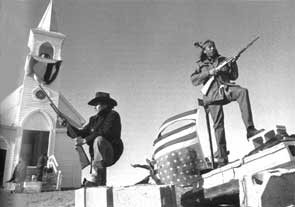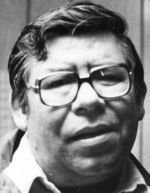 |
| Indians from all over the nation came to help the protesters. [3] |
"Let it be known, March 11, 1973, that the Oglala people will revive the treaty of 1868, and that it will be the basis for all negotiations. Let the declaration be made that we are a sovereign nation by the Treaty of 1868. We intend to send a delegation to the United Nations." [4]
When Chief Fools Crow traveled to New York to get the help from the United Nations, the U.S. government quickly put their roadblocks back up. When the chief was unable to get help, he returned to the reservation. There, he began teaching the new Indians the ways of the Lakota; they were free to practice and promote their ways. The Indians prayed, danced, and worshiped their Gods for help. Their freedom to do so reigned while other freedoms were taken away.
The government cut off the water and electricity from Wounded Knee in hopes that the protesters would surrender. When this did not work, the government cut off the one other lifeline the protesters had; the media. [5] This way, the government could be more aggressive in their interactions with the Indians and not worry about the rest of the country viewing.
On day 38, a deal was made. [6]
The government promised to investigate the corruption in the tribe as well as have an immediate White House meeting on their rights, if the Indians promised to take down arms, which they did. [7]
Opposite of the protesters' hopes and beliefs, this was not the end. The men and women occupying Wounded Knee continued to live off of limited resources for 33 days after the deal was made; making the occupation a total of 71 days. During this time, 1200 arrests were made, 12 individuals disappeared, a baby was born, a couple was married, and two protesters were killed. [8]
While these 71 days were filled with strife, the protesters think of as nothing less than 71 days of freedom in their home called Wounded Knee.
Opposite of the protesters' hopes and beliefs, this was not the end. The men and women occupying Wounded Knee continued to live off of limited resources for 33 days after the deal was made; making the occupation a total of 71 days. During this time, 1200 arrests were made, 12 individuals disappeared, a baby was born, a couple was married, and two protesters were killed. [8]
While these 71 days were filled with strife, the protesters think of as nothing less than 71 days of freedom in their home called Wounded Knee.
[1] John Kusiak, We Shall Remain: Wounded Knee, DVD, Stanley Nelson (2009: PBS), web
[2] Kusiak, We Shall.
[3] Stelleslootmaker, Wounded Knee 1973, photograph, November 12, 2009, GRIID, http://griid.files.wordpress.com/2009/11/wounded_knee_1973.jpg?w=600 (accessed May 5, 2012).
[3] Stelleslootmaker, Wounded Knee 1973, photograph, November 12, 2009, GRIID, http://griid.files.wordpress.com/2009/11/wounded_knee_1973.jpg?w=600 (accessed May 5, 2012).
[4] Dennis Banks and Richard Erdoes, Ojibwa Warrior: Dennis Banks and the Rise of the American Indian Movement (Norman: University of Oklahoma Press, 2004), 161.
[5] Kusiak, We Shall.
[6] Kusiak, We Shall.
[7] Johnson, Troy R. American Indian Acitivism: Alcatraz to the Longest Walk. Los
Angeles: Regents of the University of California, 1994.
[8] “Siege at Wounded Knee 1973.” Redhawk’s Lodge, 2002. siouxme.com/lodge/aim_73.html
[8] “Siege at Wounded Knee 1973.” Redhawk’s Lodge, 2002. siouxme.com/lodge/aim_73.html





